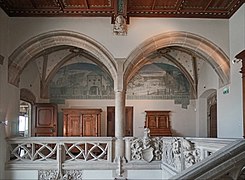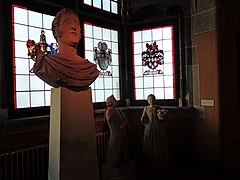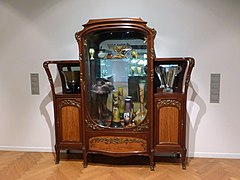Haguenau History Museum
The Musée historique ( Historical Museum ) is the city and cultural history museum of the municipality of Hagenau in Alsace (today Région Grand Est , France ). The museum has holdings of national importance in the fields of archeology , sculpture from the late Middle Ages (approx. 1400–1550) and applied arts .
The building
The museum was founded in 1900 by the long-time mayor Xaver Nessel , who was also a passionate hobby archaeologist. The building was designed by the architects Richard Kuder and Joseph Müller , who at the same time also built the Strasbourg singer's house, and inaugurated in 1905 after a five-year construction period. The extremely detailed building in the neo-renaissance style with echoes of the neo-Gothic and Art Nouveau design was intended to house the city museum as well as the city archive and library. In 1972, due to lack of space, the folk art collection was relocated to the Musée alsacien (Alsatian Museum) founded for this purpose . Since the move of the city library, only the city archive is in the same public building as the collection of the historical museum.
The collection is divided over three levels: basement ( prehistory and early history , Celts , Gallo-Roman , Merovingian ), ground floor (Middle Ages, Renaissance, Thirty Years War ) and upper floor (recent modern times ).
The collection
The historical museum preserves the (sometimes sparse) memory of numerous destroyed buildings in the city, including the imperial palace . The focus of the Hagenau collection is on the prehistoric and early finds from the Hagenau Forest , in particular from the Bronze Age and the Iron Age , most of which were excavated by Xaver Nessel himself ( Seltzer barrows ); the carving and stone masonry of the late Middle Ages, with numerous statues and reliefs from demolished churches, monasteries, chapels and secular buildings such as the former town hall, including the self-portrait by Friedrich Hammer (1542); and handicrafts, with a comprehensive collection of porcelain by Paul and Karl-Franz Hannong , Art Nouveau ceramics and glass and early modern glazed ceramics. The Art Nouveau collection of the museum owes its existence to the Hagenauer couple Henninger, which he in 2014 a total of 81 works by Gallé , Daum , Lalique , Herborth and many others along with a showcase of Majorelle with a total value of 357,600 €: bequeathed (February 2014).
Other interesting objects include artefacts from Roman times, a small collection on the city's Jewish history ( Judaica ) and Xaver Nessel's automobile, a double phaeton from the Maurer brand from 1905.
" Evangelist Johannes " (approx. 1477–78)
Fragments of a monument to the Duke of Berry (1814)
Web links
- Museum website .
Individual evidence
- ↑ Porcelain Hall of the Museum
- ^ Art Nouveau room of the museum
- ↑ Painting and ceramics room
- ↑ Collection Henninger on haguenau.fr
- ↑ voiture automobile dite system Maurer on culture.gouv.fr
Coordinates: 48 ° 48 ′ 47 " N , 7 ° 47 ′ 29" E














